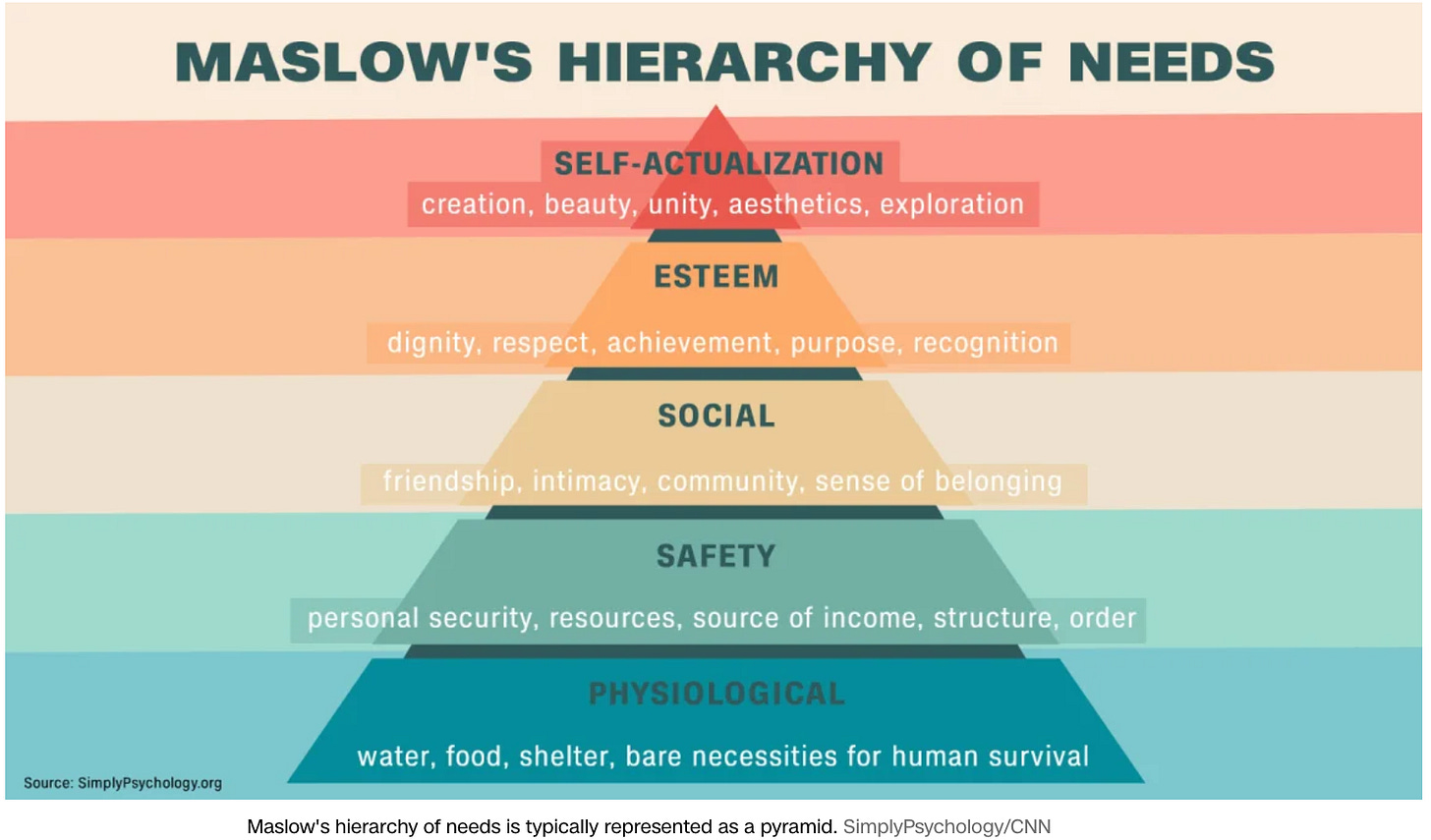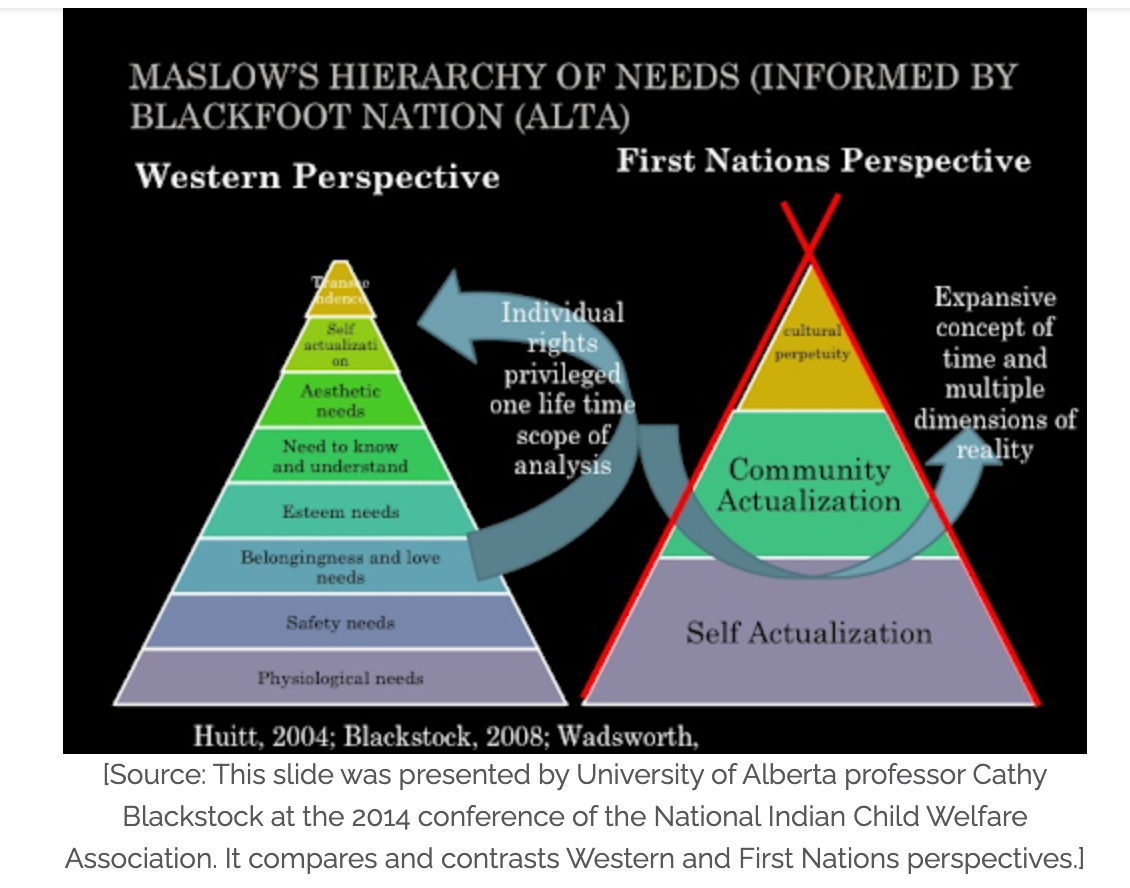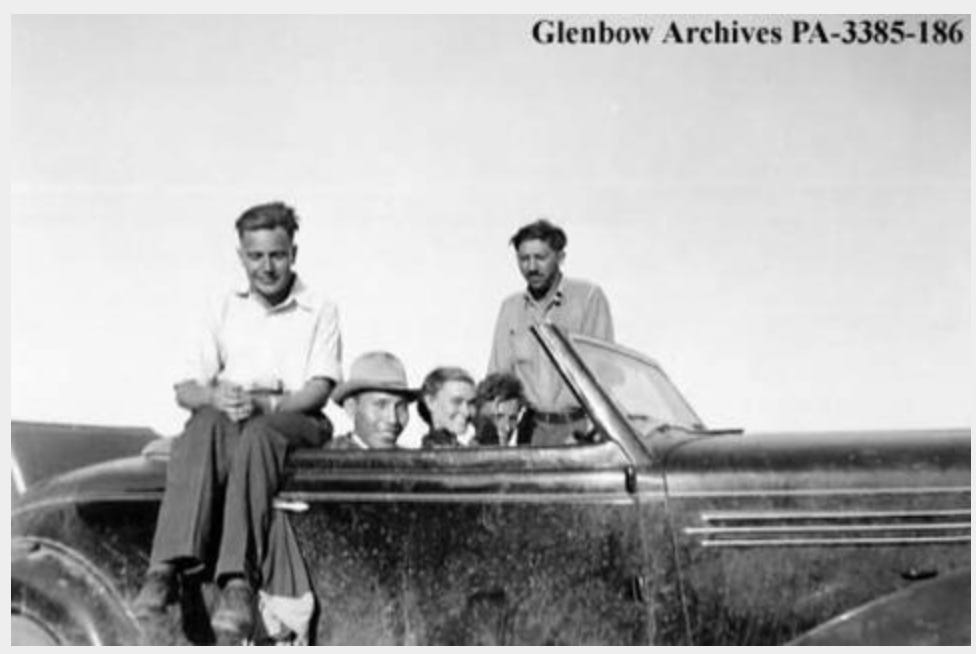I’m mad at Abraham Maslow, an American psychologist who died in 1970. It sounds silly to be mad at Maslow, but I am.
If you search for “Maslow” and “wellness,” you’ll come up with pages and pages of results carefully explaining how Abraham Maslow’s concept of a hierarchy of needs is basic to understanding health. For example, this article from CNN in 2023, goes over the basics and includes the diagram many of learned in a Psych 101 class.
This is what we might call bog standard psych in the U.S., this idea that we have basic physical needs, then safety, social, esteem and ultimately, SELF-actualization is the framework for most of the other offerings in wellness culture. People refer to it in that off-handed, taken-for-granted way as if this is True, with a capital T, and not in dispute. Here are just a few of the articles from the first page results from WebMD, BetterHelp, The Sweet Institute, and Positive Psychology.
As someone trained as a sociologist to look at big picture structural factors, and as someone who spends a lot of time working on my individual healing from those structures, I wonder often about the connection between self and society. A cliché in these spaces that drives me bananas is the line taken from airplane safety instructions to “put the oxygen mask on yourself first before helping another passenger.” People repeat this contains some fundamental truth about humans, and in some ways, I guess I shouldn’t be mad because it’s the same basic idea as Maslow’s Hierarchy of Needs: take care of your basic needs on the path to SELF-actualization.
When I’m in community healing spaces, I’m the annoying one raising my hand saying, “yes, but what about the collective?” The question I am perpetually raising in these spaces is: how does this practice of individual healing link up with our collective liberation?
Given this, it was a revelation when just last week I learned that Maslow stole the idea for the “hierarchy of needs” from the Blackfoot Nation. And, when he did this, he stripped out their idea of COMMUNITY ACTUALIZATION and replaced it with SELF.
Based on the work of Professor Cathy Blackstock, this was news to me when I learned it last week, but of course, other people who have been paying attention to indigenous ways of knowing realized this long before I did. About Maslow, Blackstock said many people are unaware that he was “stuck on his developmental theory” and went to see some friends who were conducting anthropological research on the Blackfoot reserve in Alberta. Below is an archival photo of Maslow with some First Nations people from the Blackfoot (Siksika) reserve, around 1938.
What Professor Blackstock uncovered is that Maslow lifted from the Blackfoot beliefs for his 1943 paper, “A Theory of Human Motivation.”
“First of all, the triangle is not a triangle. It’s a tipi. And the tipis in the Blackfoot (tradition) always went up and reached up to the skies,” Blackstock said (quotes from here).
In the Blackfoot way, self-actualization is at the base of the tipi, not at the top where Maslow placed it. That means self-actualization is the foundation on which community actualization is built. The highest form one can attain is, according to the Blackfoot, called “cultural perpetuity.” As Professor Blackstock explains, cultural perpetuity as something her Gitksan people call “the breath of life.” In western cultural terms, the closest to this might be that feeling of insignificance when contemplating your individual existence as you look at the ocean or a night sky full of stars. It’s the realization that you will be forgotten, but you have a part in ensuring that your people’s important teachings live on.
I have to say that this discovery gave me a twinge, just a twinge, of embarrassment. After all, I’m an expert on whiteness and wrote an entire chapter called “The Shallow Promise of Wellness Culture,” in the Nice White Ladies book. Some expert, eh, if I didn’t know this about Maslow? But I recognize this kind of thinking for the trap it is, a version of the perfectionism in white supremacy culture. This is one of the things that keeps us, white-raised folks, from acknowledging and learning how we’re harmed by these systems, the embarrassment at not knowing. It’s such a weird trap we set for ourselves. Rather than sink into the cringe of not-knowing, I prefer to transmute this into conformation that my intuition and research on wellness culture was correct even if it didn’t go far enough.
If Maslow’s “Hierarchy of Needs,” is a sham then all of wellness culture is too. The wellness culture that we’re sold rests on a notion that our highest state of being is “self-actualization” with the community part stripped out.
So, instead of trying to tamp down the irritation I feel at hearing the “put your own mask on first,” I can recognize and honor it as a reaction to the narcissism of whiteness, and a dominant culture that indexes for that kind of hyper-individualized focus on the self that disregards our need for community.
And, I can still be mad at Maslow.







Foundation altering. Good on you for bringing this to light.
That is an annoying find! But I think the idea that self-actualization is not the pinnacle of human development is actually pretty well-expressed in a number of traditions. It is from Black social service peeps that I first heard "You have to fill your own cup before you pour out." Christian and Jewish and Islamic communities are often organized around service to the faith community, and outreach beyond. It's a pretty narrow and privileged slice of humanity who actually believe self-actualization as peak humanity. Maslow is fine as far as he goes, but he stops short - and that this is apparently not out of ignorance is disappointing.